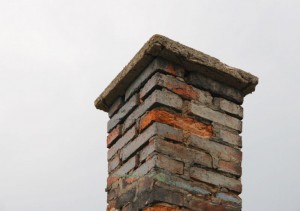The chimney is one of the most important – and often overlooked – parts of a fireplace system. However, many homeowners naively assume that their chimneys are in good condition until they begin experiencing a major problem. Just like the rest of a fireplace, the chimney itself needs regular care and maintenance in order to remain in excellent working condition. Below are a few signs that your chimney may be in trouble.
Chimney cap damage
The chimney cap is the unsung hero of most fireplace systems. Placed at the top of the chimney, chimney caps are designed to keep animals, water, and other debris from entering the chimney itself. Unfortunately, because of their location chimney cap damage is very difficult to spot as they can only be inspected from the roof.
Because of this, it is extremely important to have an annual chimney inspection completed each year. During this inspection, trained technicians will inspect the interior and exterior of the fireplace and chimney structure – including the chimney cap. If any damage is seen, recommendations for repairs can then be made.
Strange odors
While it is important to contact a professional to discover the exact cause of a fireplace or chimney odor, there are typically three main issues that cause unpleasant smells.
Water damage: If water has entered a chimney structure, it can cause mildew or mold to grow, especially during warm or humid months. Water damage in a chimney typically causes a musty, damp smell.
Creosote buildup: If you chimney has not been recently swept, a foul odor may be caused by a buildup of creosote, or the gummy, combustible byproduct left behind by wood burning fires. Many homeowners notice that the creosote odors are worse during warm months when the air conditioning is running, most likely caused by air pressure differences within a home.
Animal entry: a sharp, rotting smell accompanied by scurrying or clawing sounds may indicate that an animal has taken up residence in your chimney structure. All wild animals should be treated with caution and should only be removed by trained professionals. “Smoking out” birds or other small mammals is ineffective, as the smoke and heat from a fire often causes disorientation and even death.
Damaged masonry
As it is constantly exposed to the elements and changing temperatures, the masonry of most chimneys wears down over time. Although bricks and mortar are extremely sturdy building materials, they do need regular maintenance in order to last a lifetime. Left unrepaired, damaged masonry can allow water and debris into your fireplace system, as well as damage the structural integrity of the chimney itself.
If part of your masonry chimney is damaged, it may be possible to repair it without completely tearing down and rebuilding the chimney. Through a process called tuckpointing, Mason’s expert technicians are able to removed damaged bricks and mortar while leaving the rest of the chimney structure intact. They then replace the broken pieces and seal the joints with new, waterproof mortar. This process can eliminate safety hazards from a damaged chimney and allow it to be used for years to come.

